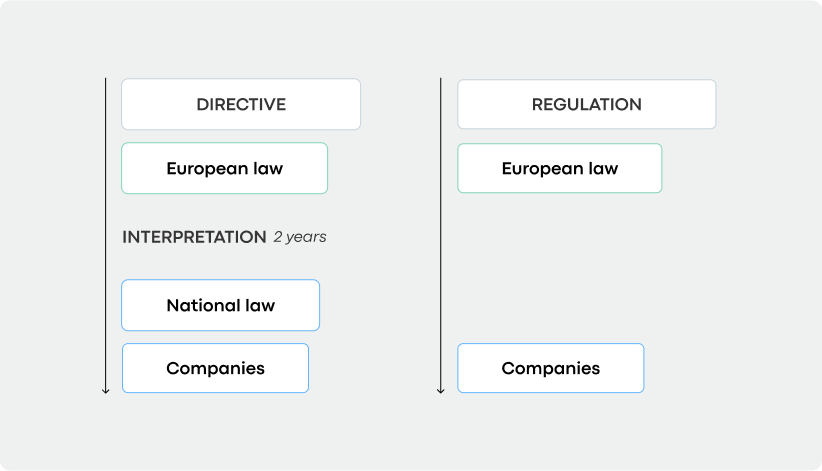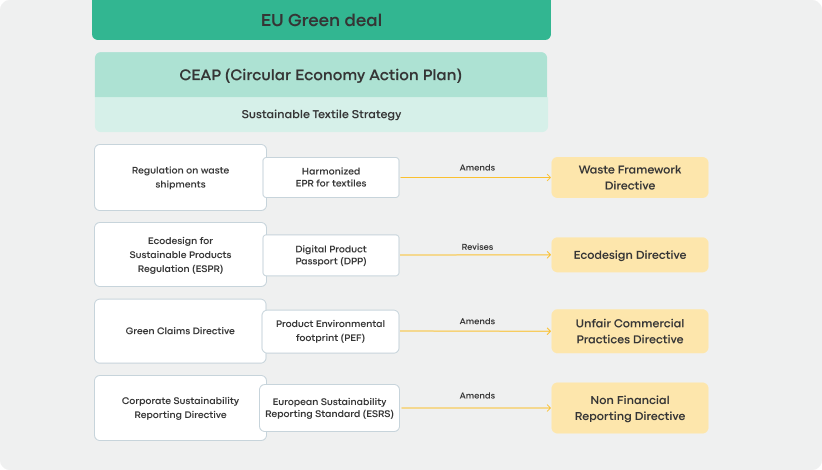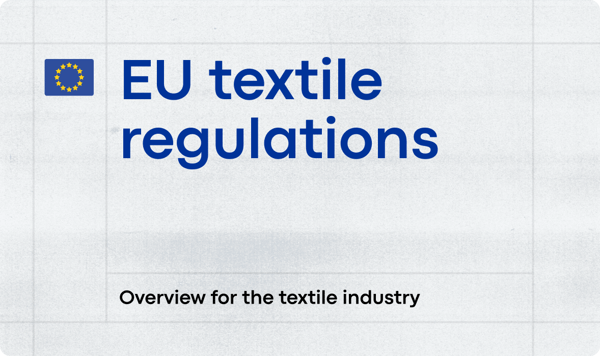The European Union (EU) is taking significant strides toward reducing carbon emissions and building a more sustainable future. Because the fashion and textile industries have such a large carbon footprint, they will be highly impacted by the numerous EU regulations and directives rolling out in the coming years. Fashion brands based in the EU and abroad will need to be aware of how these rules will affect their business in the very near future.
If you have any questions about how to stay compliant, please feel free to reach out to our team at any point or explore our hub on global textile regulations. We’d be more than happy to help!

Now, let’s first dig into the upcoming EU regulations and directives as well as regulations within the EU member states that will impact the fashion and textile industries.
But first…
Understanding EU Legislation
Before we delve into the specifics, let’s take a look at how EU legislation works. (Don’t worry, this won’t be a complicated civics lesson!)
There are two key concepts in understanding how the EU makes legislation: regulations and directives.
A regulation is basically a general law that applies to all EU countries. It’s a binding act that every country must comply with.
A directive is a legal act that sets a minimum standard for EU member states. Each member state must enact their own laws or regulations within a two year period to comply with the minimum requirements of the directive. Member states can also choose to go beyond the minimum requirements set out in the directive.
What does this mean for you? There are both EU-wide laws AND upcoming national laws that your fashion brand will need to comply with. In regard to climate change, all new regulations and directives are part of the European Green Deal, which sets a roadmap for all future environmental legislation.

EU legislative process
The EU legislative process involves the proposal of legislation by the European Commission, which is then reviewed and potentially amended by the European Parliament and the Council of the European Union. If both bodies agree on the text after a dialogue phase, which can span several years, the legislation is adopted. A Regulation becomes binding across all EU member states directly, without the need for national transposition, and enters into force 20 days after its adoption. Following the adoption of a Regulation, Delegated Acts can be developed. Delegated Acts are secondary laws that specify or amend non-essential elements of the original legislation, allowing for adjustments or details (e.g. to certain industries) to be added without going through the full legislative process again.
Both Directives and Regulations go through the EU legislative process involving the European Commission, the European Parliament, and the Council of the European Union. Once adopted, however, their paths diverge, directives must be transposed by each member state into its national law by a given deadline.
.png?width=822&height=471&name=EU%20process%20(1).png)
Let’s start there.
The European Green Deal
The European Green Deal aims to make Europe the first climate-neutral continent by 2050. To do so, it establishes ambitious environmental goals and targets, which in turn serve as the foundation for directives and regulations that are continually being introduced. Among its primary objectives are significant reductions in net greenhouse gas emissions, targeting a minimum decrease of 55% by 2030 as compared to the levels recorded in 1990. Emphasizing the importance of reforestation and ecosystem restoration, the initiative also strives to plant 3 billion trees within the EU by the year 2030.
Within the European Green Deal, there are two concrete plans that are pertinent to understanding current and upcoming climate legislation.
EU Circular Economy Action Plan (CEAP)
The CEAP is a cornerstone of the European Green Deal. Comprising 35 specific actions, it places a special spotlight on the textiles sector, which is recognized as one of the most resource-intensive industries. The Circular Economy Action Plan introduces an array of initiatives that are crafted to promote sustainable product design, establish circular economy practices, and curtail waste generation.
EU Strategy for Sustainable and Circular Textiles
To implement the commitments of the European Green Deal and the new CEAP, the EU has developed a specific strategy for the textiles sector. The EU Strategy for Sustainable and Circular Textiles will reinvent the entire lifecycle of textile and footwear products, not only changing how fabrics are made, but how they are consumed, and eventually disposed of. This includes: increasing the longevity of textiles, increasing the use of recycled fibers, curbing fast fashion, and making products easier to repair or recycle with a Digital Product Passport.
Now let’s take a look at the main climate regulations and directives, and how they affect fashion and textile companies in greater detail.

EU Omnibus
The Omnibus Simplification Package is part of the EU’s strategy to streamline corporate sustainability reporting. Released in February 2025, the package proposes changes to:
- The Corporate Social Responsibility Directive (CSRD),
- The Corporate Social Due Dilligence Directive (CSDDD),
- The EU Taxonomy, and
- Carbon Border Adjustment Mechanism (CBAM)
The draft proposal, released on February 26, 2025, has already sparked significant debate.
On 26 March 2025, member states' representatives (Coreper) approved the Council’s position on the Commission's 'Stop-the-clock' directive, a key part of the Omnibus Simplification Package. As part of this update, the Council agreed to delay:
-
The entry into application of the CSRD for large companies that have not yet begun reporting, as well as for listed SMEs, by two years, extending the deadline to 2028.
-
The transposition deadline and first-phase application of the CSDDD, covering the largest companies, by one year, now set for 2027.
These extensions are aimed at providing businesses with more time to prepare for compliance and allowing for further negotiations on substantive changes to the CSRD and CSDDD, which are part of the ongoing Omnibus I package.
Corporate Sustainability Reporting Directive (CSRD)
Current Status: Approved EU law
While not part of the European Green Deal, the Corporate Sustainability Reporting Directive works in tandem with these new regulations as part of the Sustainable Finance Initiative. Essentially, the CSRD requires companies to not only consider their financial health, but their sustainability as well. It will have numerous implications for fashion and textile brands.
This directive will mandate enhanced sustainability reporting, making it applicable to large companies with 250 or more employees and all companies listed on the EU market. Eventually it will apply to a number of non-EU corporations. It will require these companies to provide detailed disclosures on environmental, social, and governance (ESG) matters, such as greenhouse gas emissions, supply chain transparency, labor practices, and diversity initiatives. By doing so, fashion and textile brands will face increased scrutiny and accountability, compelling them to adopt more sustainable practices.
Even though the CSRD was adopted in 2023, the entry into application of the CSRD for large companies that have not yet begun reporting, as well as for listed SMEs, has been delayed by two years, extending the deadline to 2028. The EU published the European sustainability reporting standards (ESRS), this standard operates as the framework for the disclosure of environmental, social and governance information.
Read our Fashion CSRD deep dive
Ecodesign for Sustainable Products Regulation (ESPR)
Current Status: Approved EU law, from July 2024
Because product design determines 80% of a product’s environmental impact, the current Ecodesign Directive, which currently only covers energy-related products, will be expanded to include textiles, and other sectors will follow. This regulation aims to make products more “durable, reliable, reusable, upgradable, reparable, easier to maintain, refurbish and recycle, and energy and resource efficient.”
Fashion brands wishing to sell in the EU marketplace will need to address product design from beginning to end, taking into account a product’s durability, recyclability, and inclusion of recycled materials. For the fashion and textile sector, this means greater transparency and traceability, enabling consumers to make informed choices based on sustainability factors. The new ecodesign requirements for textiles are expected to be finalized by mid 2025.
The regulation also introduces the Digital Product Passport, which will make it easier for consumers to repair or recycle products as well as track potentially dangerous substances throughout the supply chain.
Digital Product Passport (DPP)
As mentioned above, the Digital Product Passport will have significant implications for the fashion and textile industry. All products placed on the European market must have a product passport. This tool will serve as a digital record that provides comprehensive information about a product's environmental footprint throughout its lifecycle.
Every product must include a machine-readable passport—such as a QR code—that is linked to a unique product ID. For fashion and textile brands, this can include:
- The product’s durability, reusability, and repairability
- Percentage of recycled content
- The product’s carbon footprint
- And the product’s circularity, among other requirements
The European Commission will be establishing a dedicated web portal where all digital product passports will be registered. The data carrier present on products linking to the Digital Product Passport is still to be decided by the Commission and is expected to be known for textiles by the end of 2025.
Read our fashion & textiles DPP deep dive here
Waste Framework Directive
Current Status: Approved EU law
In 2021, the Waste Framework Directive was adopted. This initial directive aimed to foster a circular economy and ensure that the EU does not ship its textile waste to developing nations. It made it easier to transport waste and recycle within the EU, as well as improve measures to track illegal waste shipments.
You’re likely to see the acronym Textile EPR—short for Extended Producer Responsibility—used in reference to this directive. It contained several new rules that will “make producers responsible for the full lifecycle of textile products.” That includes everything from product design to textile waste and recycling. Member States will be required to establish systems for the separate collection of textile waste by January 1, 2025. Every country will have their own EPR, and each as a fashion brand you will have to join an EPR for each country.
Read our fashion & textiles EPR deep dive here
Revision of the Waste Framework Directive
Current Status: Provisional agreement
In 2023, the European Commission proposed an amendment to the Waste Framework Directive, targeted to the textile industry. There are currently numerous textile EPRs in use across the different Member States, and the goal of this new regulation is to harmonize them.
The new Regulation on Waste Shipments will facilitate the sustainable management of textile waste across the EU, making textile producers responsible for the costs of textile waste management. The goal is to encourage them to reduce waste and increase the circularity of their products. Once producers are responsible for covering the cost of textile waste management, they will have a fresh incentive to reduce waste and make their products more circular. How much will it cost? The fee will be based on “eco-modulation”, the overall environmental performance of the textile.
Read our Waste Framework revision fashion deep dive here
Revision of the Textile Labeling Regulation
Current Status: Draft phase
The current Textile Labeling Regulation is limited to fiber, which has led to a confusing amalgamation of labeling systems across the EU. It also does not keep pace with the development of new fabrics and recycling technologies. The EU Commission plans to revise the current Textile Labeling Regulation in the fourth quarter of 2023, which will streamline product label requirements. The draft proposal, is expected in September 2025.
It will introduce specifications for both the physical and digital labeling of textiles. Brands will need to implement more comprehensive and standardized labeling practices, ensuring that consumers have access to accurate information about the composition and origin of textile products. As a result, fashion and textile brands must prepare to adapt their labeling procedures to comply with these new regulations, thereby promoting fair competition and bolstering consumer confidence in their products. We will update this text once the revisions are made public.
Unfair Commercial Practices Directive (UCPD)
Current Status: Approved EU law
The Unfair Commercial Practices Directive (UCPD), established in 2005 for consumer protection, recently incorporated sustainable claim guidelines in December 2021. Currently, it's the only EU regulation addressing environmental claims. However, the upcoming Green Claims Directive, proposed in March 2023, will introduce specific rules for substantiating and communicating green claims, along with environmental labeling regulations. These directives complement each other by setting guidelines for companies to follow, focusing on substantiation and verification.
The UCPD, while applicable to various commercial practices, particularly influences environmental claims and labeling. It defines "environmental claims" as practices suggesting positive environmental impacts. Real-life examples of greenwashing include labeling non-recyclable polyester as "recycled" and advertising "energy-efficiency" without reducing the supply chain's environmental impact.
Although less specific than the Green Claims Directive, the UCPD provides guidelines for voluntary environmental claims:
- Assess a product's environmental impact across its entire lifecycle and supply chain.
- Ensure environmental claims relate specifically to the product, not general sustainability practices.
- Maintain clear and unambiguous communication about key environmental impacts.
- Conduct comparative assessments using the same method and criteria when claiming a lower environmental impact compared to competitors.
Notably, the UCPD has already been enforced against major fashion retailers like H&M and Decathlon for sharing misleading environmental claims without context or clarity.
Read our apparel and footwear UCPD deep dive here
Directive on Green Claims
Current Status: Proposal
With 230 different environmental labels, it’s no wonder consumers are confused when trying to buy a more sustainable, eco-friendly product. On top of that, “53% of green claims give vague, misleading or unfounded information” and “40% of claims have no supporting evidence.” The Green Claims Directive will empower consumers to make informed decisions, by mitigating greenwashing and misleading environmental claims.
Any green claims—such as “this product has a reduced carbon footprint”—will need to be independently, third-party verified and scientifically proven. Additionally, there will be rules ensuring claims are clearly communicated. For example, aggregate scoring of a product’s environmental impact may no longer be allowed. And any new labeling schemes will no longer be allowed, unless permitted by the EU and can clearly demonstrate added value to the authorities.
This directive aims to improve the information presented on product labels, particularly in regards to their durability and repairability. As such, any claims related to the sustainability of a garment will need to be substantiated by third-party reviewed data, obtained by using a standard methodology for life cycle assessment (LCA).
Read our fashion Green Claims deep dive here
Product Environmental footprint method (PEF for apparel and footwear)
Current Status: Implementation phase
The EU is working on the product environmental footprint method (PEF), which specifically contains data for the apparel and footwear sector. The PEF incorporates several environmental indicators into a product's environmental footprint assessment, including factors such as carbon emissions, water usage, energy consumption, and more.
Once the Green Claims Directive has been implemented, it will be even more important for fashion and textile brands to incorporate a carbon management tool such as Carbonfact into their workflow.
Housed within the PEF method are PEF Category Rules (PEFCR), designed to provide more specific guidelines for individual product categories. Previously, the Apparel & Footwear PEFCR was set to launch in Q4 2024. However, due to recent adjustments in the review process, the final release has been pushed to April 2025.
PEFCR is being developed by considering circularity (use and recyclability of materials), durability (both emotional and physical longevity of products), and repairability (ease of repair to extend lifespan). The Apparel and Footwear PEFCR will comprehensively cover all categories of garments and footwear.
The PEFCR is scheduled to be officially adopted in 2025 by the European Commission, which then can be used for future legislation.
Corporate Sustainability Due Diligence Directive (CSDDD)
Current Status: Approved EU law
Fashion and textile brands will need to develop due diligence policies, identify human and environmental impacts of their activities, and prevent potential or actual negative effects. All of this, of course, must be communicated publicly for both regulators and consumers. Essentially, this directive is about creating visibility and traceability throughout your value chain.
This directive will affect apparel and footwear companies with 1000 employees and >EUR 450 million turnover (net) worldwide. For non-EU companies, the criteria will be EUR 450 million turnover (net) in the EU. Micro companies and SMEs are not covered by the proposed rules. However, the Directive provides supporting and protective measures for SMEs, which could be indirectly affected as business partners in value chains.
It's important to highlight that this is not about achieving specific results; instead, it's about companies making a concerted effort to improve their environmental and social impacts. In other words, the directive expects companies to take meaningful steps towards sustainability and ethical practices, but it doesn't require them to achieve certain predetermined outcomes.
The CSDDD has been formally adopted by the EU on 24 May 2024. Member States will have two years to implement the CSDDD into national law. As the CSDDD is a directive, member states can go above and beyond the minimum requirements set out by the EU.
The directive will apply depending on the size of the companies following this timeline:
- 2027 for textile companies with >5000 employees and €1500 million turnover
- 2028 for companies with >3000 employees and €900 million turnover
- 2029 for companies with >1000 employees and €450 million turnover
EU Deforestation Regulation (EUDR)
Current status: Approved EU law
The EU Deforestation Regulation (EUDR), which entered into force on 29 June 2023, seeks to curb global deforestation linked to the EU market by making companies responsible for ensuring that their products are not linked to deforestation or forest degradation.
The regulation applies to several high-risk commodities, including cocoa, coffee, soy, palm oil, and timber, as well as products made from these materials, such as leather, chocolate, and furniture. Companies must prove that their products are not associated with land cleared after 31 December 2020.
Key dates:
- 29 June 2023: EUDR entered into force.
- 30 December 2025: Rules apply to medium and large operators and traders.
- 30 June 2026: Rules apply to micro and small enterprises.
Non-compliant businesses will face penalties and may be restricted from selling in the EU.
Omnibus Simplification Package
Introduced on February 26, 2025, as part of the EU’s Competitiveness Compass, the Omnibus Simplification Package proposes changes to key sustainability regulations, including CSRD, CSDDD, and the EU Taxonomy. While aimed at reducing compliance burdens, the proposal has sparked debate, with concerns that it could weaken transparency and limit industry-wide sustainability data.
If enacted, the main proposed changes would be:
- Alignment of CSRD and CSDDD Scope: CSRD now applies only to companies with 1,000+ employees, aligning with CSDDD and exempting ~80% of previously in-scope companies, including listed SMEs. A new “Small Mid-Cap” category (250–1,500 employees, <€1.5B sales) faces lighter reporting obligations.
- Delayed Implementation Timelines: CSRD Wave 2 and 3 reporting is postponed to 2028 (from 2026), while CSDDD compliance is delayed to 2028. Extended to 2027 is transposition, a process by which EU Member States incorporate EU directives into their national legal systems.
- Limited Value Chain Data Requests: Companies cannot demand extensive sustainability data from business partners with fewer than 1,000 employees, including suppliers and subcontractors, except in high-risk cases.
- ESRS Standards Revision: From 2028, ESRS will have fewer mandatory data points, more quantitative focus, and clearer mandatory vs. voluntary disclosures.
- Sector-Specific Standards Removed: CSRD/ESRS sector-specific sustainability reporting requirements are eliminated.
However, the Omnibus is still a proposal and must go through political negotiations before becoming law. If it’s not enacted by December 2025, Wave 2 companies will still be required to report in 2026. With this uncertainty, brands should continue preparing for compliance to avoid last-minute scrambling.
Read all about the Omnibus Simplification Package here,
After exploring the most pressing textile laws and regulations in the EU, let's now look at the current and forthcoming laws by EU membership states.
France: Anti-Waste Law for a Circular Economy (AGEC law)
Current Status: Approved French law
France's Anti Waste Law for a Circular Economy was first published in 2020, and revised in 2023. The AGEC law is France’s national EPR law as required by the EU Waste Framework Directive (see above). This legislation aims to eliminate the improper disposal of waste, as well as reduce waste all together. In particular, it will tackle single-use plastic packaging, phasing it out altogether by 2040. This will include the plastic polybags that many fashion brands use to distribute their products. Additionally, fashion and textile brands will be required to extend the lifespan of their products through repairability and durability, as well as establish systems for collecting and recycling textile waste.
Moreover, fashion brands will need to develop eco-design principles to minimize the environmental footprint of their products. This law also prohibits the destruction or incineration of unsold goods, compelling brands to find more sustainable ways of handling excess inventory.
Read our France textile EPR deep dive here
France: The Climate & Resilience Law – Environmental Labeling for Products
Current Status: Approved French law
The Climate & Resilience Law was passed in 2021, and as of January 2023, all large fashion corporations with €50M+ turnover and 25,000 units sold in France will be required to provide an environmental impact label on their products.
Eventually, this law will apply to all companies with €10M+ turnover and 10,000 units. This mandatory disclosure aims to empower consumers to make informed choices by promoting transparency and eco-consciousness.
The label is meant to be inclusive, showcasing a product’s environmental and social impact throughout its entire life cycle.
Brands must implement a comprehensive carbon and environmental management system, such as Carbonfact, in order to track environmental data across the entire life cycle of a product.
Read our Textile Eco-Score in France deep dive here in English
The Netherlands: Extended Producer Responsibility
Current Status: Approved Dutch law
Similar to other EPR laws, the Dutch Extended Producer Responsibility for Textiles aims to improve the circular economy within the fashion industry. Beginning July 1, 2023, all fashion and textile producers either based in the Netherlands or selling on the Dutch market will be responsible for the collection, recycling, reuse, and waste of their products. This regulation applies to apparel, as well as household items like bed linens and tablecloths.
What does that look like in practice?
Fashion or textile brands will need to provide collection locations for consumers to drop off their unwanted items, prove that the textile waste is properly recycled or reused, and report on the amount of textiles imported into the Dutch market. On top of that, brands will need to complete a one-time registration at Rijkswaterstaat, the Dutch government agency responsible for managing water systems in the Netherlands.
Starting in 2024, brands will be required to submit an annual report; and starting in 2026, they will need to include objectives in their documentation, including:
- Textiles put on the market in 2024 will need to include at least 50% recycled materials, 20% of which are prepared for reuse.
- In 2029, all textiles will need to include 75% recycled materials with 25% prepared for reuse.
Read our Dutch textile EPR deep dive here
Norway: Transparency Act
Current Status: Approved Norwegian law
In effect since 2022, the Norwegian Transparency Act carries substantial implications for fashion and textile brands operating in Norway. The primary aim of this act is to enhance transparency and promote respect for human rights and decent working conditions throughout the entire value chain of businesses.
To achieve this, the act mandates that companies conduct due diligence assessments and document their efforts to mitigate associated risks. Because it is aligned with the UN Guiding Principles on Business and Human Rights and OECD Guidelines for Multinational Enterprises, there may be revisions in the future that require reporting on environmental impact and risk.
Currently the act mandates that companies should:
- Conduct routine due diligence evaluations in line with OECD's multinational company guidelines, focusing on human rights and labor conditions.
- Assess the impact of their business operations, supply chains, and partnerships on human rights and working conditions.
- Thoroughly investigate and mitigate risks associated with human rights and working conditions.
- Respond to public requests by providing compliance information within a maximum of three weeks, or within two months if necessary.
- Make due diligence assessments readily accessible via the company website.
This legislation is applicable to large and mid-size companies either based in Norway or providing goods and services in the country. Companies meeting specific financial criteria, such as over 70 million NOK (ca EUR 6m, USD 6.5m) in sales revenue, over 35 million NOK in balance sheet total, or over 50 average employees in the financial year, fall within its purview.
Germany: Supply Chain Due Diligence Act
Current Status: Approved German law
Similar to Norway’s Transparency Act, this piece of German legislation addresses human rights and working conditions in the supply chain. Fashion and textile brands will be required to implement rigorous due diligence processes throughout their supply chains, focusing on human rights and environmental standards. This includes monitoring and reporting on potential risks and adverse impacts in their global operations, such as:
- Creation and use of pollutants
- The handling of hazardous waste
- Child and forced labor
- Discrimination and inequality in the workplace
Moreover, companies will need to establish effective grievance mechanisms and provide transparent, accessible information to the public and authorities.
Now in effect as of January 2023, this law applies to large businesses operating in Germany and will levy a 2% fine on global turnover, as well as a potential ban from public contracts, for failure to comply. Currently it applies to companies with more than 3,000 employees in Germany, and in 2024 it will extend to businesses with 1,000 or more.
How to stay compliant with the upcoming EU textile regulations
As the EU continues to introduce and refine its climate regulations and directives, it will be essential for apparel and textile brands to have a clear understanding of their products’ environmental impact throughout the entire life cycle. As an apparel or footwear brand, it’s important to prepare for the EU textile strategy regulations and directives—especially as gathering and consolidating all your data takes quite a lot of effort. You will be required to report retroactively, so it is important to get the right tools in place now.
Carbonfact is here to help. We are a team of climate scientists, engineers, and data experts who came together to build innovative software to simplify environmental footprint measurement for fashion and textile brands.
We deliver accurate, third-party reviewed environmental data for each of your products, so fashion brands can reduce their absolute and per unit environmental footprint.
Get in touch to see how we can help you stay compliant.








![[Guide] Carbon accounting for fashion, textile, apparel, and footwear companies](https://www.carbonfact.com/hs-fs/hubfs/CA%20-%20Opt1.png?width=600&name=CA%20-%20Opt1.png)
 Angie Wu
Angie Wu

 Lidia Lüttin
Lidia Lüttin
